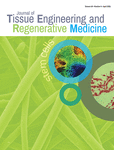Histatin-1 is a novel osteogenic factor that promotes bone cell adhesion, migration, and differentiation
Pedro Torres and Nadia Hernández contributed to this study.
Abstract
Histatin-1 is a salivary antimicrobial peptide involved in the maintenance of enamel and oral mucosal homeostasis. Moreover, Histatin-1 has been shown to promote re-epithelialization in soft tissues, by stimulating cell adhesion and migration in oral and dermal keratinocytes, gingival and skin fibroblasts, endothelial cells and corneal epithelial cells. The broad-spectrum activity of Histatin-1 suggests that it behaves as a universal wound healing promoter, although this is far from being clear yet. Here, we report that Histatin-1 is a novel osteogenic factor that promotes bone cell adhesion, migration, and differentiation. Specifically, Histatin-1 promoted cell adhesion, spreading, and migration of SAOS-2 cells and MC3T3-E1 preosteoblasts in vitro, when placed on a fibronectin matrix. Besides, Histatin-1 induced the expression of osteogenic genes, including osteocalcin, osteopontin, and Runx2, and increased both activity and protein levels of alkaline phosphatase. Furthermore, Histatin-1 promoted mineralization in vitro, as it augmented the formation of calcium deposits in both SAOS-2 and MC3T3-E1 cells. Mechanistically, although Histatin-1 failed to activate ERK1/2, FAK, and Akt, which are signaling proteins associated with osteogenic differentiation or cell migration, it triggered nuclear relocalization of β-catenin. Strikingly, the effects of Histatin-1 were recapitulated in cells that are nonosteogenically committed, since it promoted surface adhesion, migration, and the acquisition of osteogenic markers in primary mesenchymal cells derived from the apical papilla and dental pulp. Collectively, these observations indicate that Histatin-1 is a novel osteogenic factor that promotes bone cell differentiation, surface adhesion and migration, as crucial events required for bone tissue regeneration.
CONFLICT OF INTERESTS
The authors declare that there are no conflicts of interests.
AUTHOR CONTRIBUTIONS
Pedro Torres, Nadia Hernández, and Vicente A. Torres designed research, performed research, analyzed data, and wrote the paper; Carlos Mateluna, Patricio Silva, Montserrat Reyes, Luis Solano, Sebastián Venegas, Kamran Nazmi, and Mauricio Garrido, and Mónica Cáceres performed research and analyzed the data; Floris J. Bikker, Jan G. M. Bolscher, Alfredo Criollo, Mónica Cáceres, and Vicente A. Torres contributed with reagents and analytic tools and reviewed the paper.




